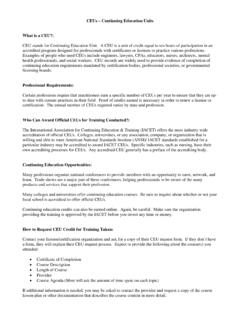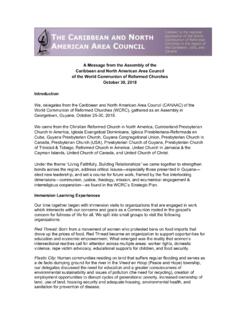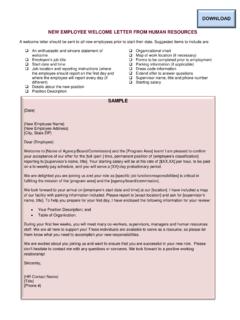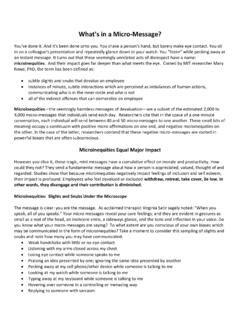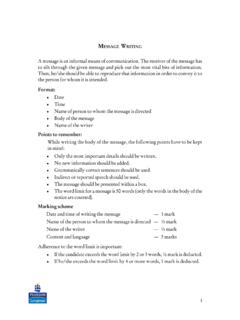Transcription of Covello message mapping
1 message mapping Vincent T. Covello , One of the most important tools available to a risk communicator is the " message map." As illustrated in template form in Figure 1, a message map is a roadmap for displaying detailed, hierarchically organized responses to anticipated questions or concerns. It is a visual aid that provides at a glance the organization's messages for high concern or controversial issues. Developing and using message maps achieves several important risk communication goals: (1) identifying stakeholders early in the communication process (2) anticipating stakeholder questions and concerns before they are raised; (3) organizing our thinking and developing prepared messages in response to anticipated stakeholder questions and concerns; (4) developing key messages and supporting information within a clear, concise, transparent, and accessible framework; (5) promoting open dialogue about messages both inside and outside the organization; (6) providing user friendly guidance to spokespersons; (7) ensuring that the organization has a central repository of consistent messages; (8) encouraging the organization to speak with one voice.
2 The process used to generate message maps can be as important as the end product. message mapping exercises involving teams of scientists, communication specialists, and policy experts often reveal a diversity of viewpoints within an organization for the same question, issue, or concern. Gaps in message maps often provide early warnings of message incompleteness. They represent opportunities for focused efforts by issue management teams, and also may provide clues for needed changes in strategy or policy. Several steps are involved in constructing a message map. The first step is to identify stakeholders -- interested or affected parties for a selected issue of high concern, such as a bio-terrorist attack. The second step is to identify a complete list of stakeholder questions and concerns. A partial list of categories of stakeholder concerns is presented in Figure 2.
3 Lists of general and specific stakeholder questions and concerns are typically generated through research, including media content analysis, reviews of historical documents (such as public meeting transcripts), interviews with issue experts, facilitated discussion sessions with those who are familiar with the issue, focus groups, and surveys. Most questions that will be raised related to a controversy or concern can be anticipated. When questions are accumulated through a thorough and systematic process, a realistic goal is to anticipate at least 95 percent of the questions that will actually be asked. Figure 3 provides a partial list of questions generated through a message mapping exercise related to bio-terrorism and smallpox. The third step in message map construction is to analyze these questions to identify common sets of underlying concerns. Case studies indicate that most public health issues are associated with 8-15 primary underlying concerns from the perspective of the intended receiver.
4 The fourth step in message map construction is to develop key messages in response to the generated list of underlying stakeholder concerns and specific stakeholder questions. Key messages are typically developed through brainstorming sessions with a message mapping team. The message mapping team typically consists of a subject matter expert, a communication specialist, a policy expert, and a facilitator. The brainstorming session produces a message narrative, which in turn is reduced to key messages and entered on the message map. Key message construction by the message mapping team is based on principles derived from one of the main theories of risk communication -- mental noise theory. Mental noise theory states that when people are upset they often have difficulty hearing, understanding, and remembering information. Mental noise can reduce a person s ability to process information by over 80 percent.
5 The challenge for risk communicators, therefore, is (1) to overcome the barriers that mental noise creates and (2) to produce accurate messages for diverse audiences; and (3) to achieve maximum communication effectiveness within the constraints posed by mental noise. Solutions to mental noise theory that guide key message development specifically, and message mapping generally, include: Developing a limited number of key messages: ideally 3 key messages or one key message with three parts for each underlying concern or specific question (conciseness); Keeping individual key messages brief: ideally less than 3 seconds or less than 9 words for each key message and less than 9 seconds and 27 words for the entire set of three key messages (brevity). Developing messages that are clearly understandable by the target audience: typically at the 6th to 8th grade readability level for communications to the general public (clarity).
6 Additional solutions include: Placing messages within a message set so that the most important messages occupy the first and last positions. Developing key messages that cite credible third parties. Using graphics and other visual aids to enhance key messages. Balancing negative key messages with positive, constructive, or solution oriented key messages. Avoiding unnecessary uses of the words no, not, never, nothing, none. The fifth step in message map construction is to develop supporting facts and proofs for each key message . The same principles that guide key message construction should guide the development of supporting information. Guidelines for Using message Maps Use one or all of the three key messages on the message map as a media sound bite. Present the sound bite in less than 9 seconds for television and less than 27 words for the print media. When responding to specific questions from a reporter or stakeholder regarding a key message , present the supporting information from the message map in less than 9 seconds or 27 words.
7 If time allows, present the key messages and supporting information contained in a messages map using the Triple T Model : (1) Tell people what you are going to tell them, , key messages; (2) Tell them more, , supporting information; (3) Tell people again what you told them, , repeat key messages. Study and practice the use of message maps. Stay on the prepared messages in the message map; avoid winging it. Take advantage of opportunities to reemphasize or bridge to key messages. Keep messages short and focused. Be honest: tell the truth. In conclusion, message maps are a viable tool for risk communicators. They ensure that risk information has the optimum chance of being heard, understood, and remembered. Importantly, they encourage public health agencies to develop a consistent set of messages and speak with one voice. ======================================== =============================== Figure 1: message Map Template Stakeholder: Question or Concern: Key message 1 Key message 2 Key message 3 Supporting Fact 1-1 Supporting Fact 2-1 Supporting Fact 3-1 L Supporting Fact 1-2 Supporting Fact 2-2 Supporting Fact 3-2 Supporting Fact 1-3 Supporting Fact 2-3 Supporting Fact 3-3 ======================================== ============================= ======================================== ============================= Figure 2: Sample Categories of Concern ======================================== ============================= 1.
8 Health and Safety 2. Ecological 3. Economic 4. Quality of Life 5. Equity/Fairness 6. Cultural and Symbolic 7. Legal and Regulatory 8. Basic Informational -- Who, What, Where, When, Why, Wow 9. Openness, Transparency, and Access to Information 10. Accountability 11. Options and Alternatives 12. Control 13. Voluntariness 14. Benefits 15. Trust ======================================== ============================ Figure 3: Examples of Smallpox Questions ======================================== ==================================== How contagious is smallpox? Can everyone be vaccinated? What are the signs and symptoms of smallpox? Who s in charge? Why is smallpox a good weapon? What makes you think the strategies of the 60s and 70s will work today? What s being done to prepare? What kind of medical care will be available? Is there enough?
9 What resources will be used to identify and respond to an outbreak? Could terrorists make a strain that you couldn t protect against? Are enough resources available to care for smallpox patients? Are laboratories able to quickly diagnose smallpox? How do you know the new vaccine will work? Isn t it true that smallpox has been known to be airborne in the past? Can I get smallpox from water, mosquitoes, pets, or farm animals? What are state and local health departments doing to prepare? Is it true that the vaccine comes from aborted fetuses? How are bioterrorism funds being spent? What do I do if I think I have smallpox? Should people get vaccinated? Is the vaccine licensed and approved? What does IND mean? What is the government doing to make the vaccine safer? Who will tell me when I need to get vaccinated? Is there an adequate supply of medicines available to treat vaccine complications?
10 What are the alternatives to vaccination? What should happen after I get vaccinated? Why a plan now? What does the plan say? Why does the plan say what it says? How do you know the risk is low? Are we already at risk? How prepared are you in the event of a smallpox outbreak? How do you know whether a smallpox threat is a hoax or not? If I get sick from the vaccination, who will take care of my family, my pets? Does the CDC recommend that I get smallpox vaccinations? Can pets be vaccinated? Are the smallpox vaccines licensed and approved? What does Investigational New Drug (IND) mean? What are the differences between the different types of smallpox vaccine? What is the CDC doing to make smallpox vaccine safer? How long does it take for smallpox vaccination to protect against smallpox? Are there people who cannot be protected by smallpox vaccination? How do I keep the vaccination virus from spreading from my vaccination to other people?


